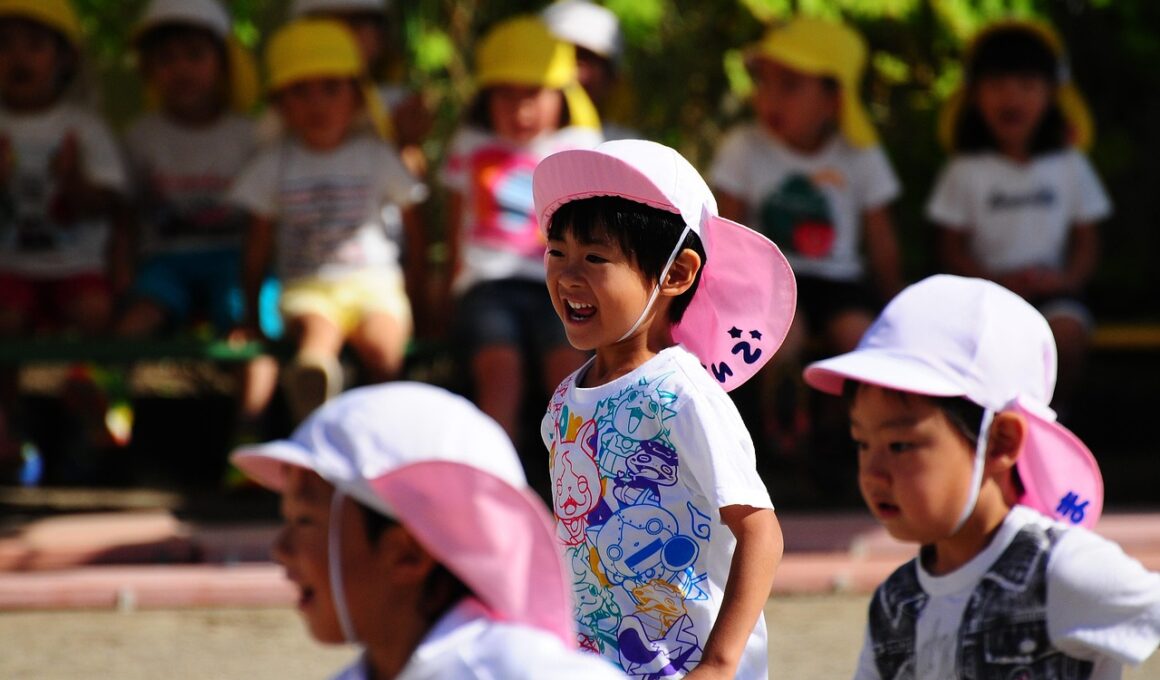Relay Races: Fun Fitness Activities for Kids and Teens
Relay races are an excellent way to combine fitness with fun for kids and teens. These activities not only promote physical fitness but also encourage teamwork and cooperation among participants. Engaging in relay races helps improve speed, agility, and endurance, making them beneficial for overall health. Various formats of relay races can be adapted to suit different age groups and skill levels. Teachers, coaches, and parents can easily organize these races in parks, gymnasiums, and playgrounds. Participants can take turns in teams, passing batons or completing specific tasks at each leg of the race. The excitement builds as kids cheer for their members, fostering a sense of camaraderie and support. Additionally, relay races can be themed or tailored to incorporate fun elements such as obstacles or silly costumes. This not only maintains a high level of engagement but also makes fitness enjoyable. The creativity in structuring these races allows for plenty of variations, ensuring that no two races are ever the same. By encouraging active participation, relay races can instill a lifelong love for fitness among kids and teens.
Types of Relay Races
Understanding the different types of relay races can inspire exciting variations for kids and teens. Traditional relay races typically involve teams racing against each other, passing a baton to complete each segment. However, teams can participate in themed races such as obstacle relays, where members must navigate challenges before passing the baton. Water relays are also popular, where participants must transport water from one bucket to another without spilling. Another fun option is the dress-up relay, requiring participants to put on silly costumes or accessories before running. These creative variations make fitness entertaining, ensuring that children are not only active but also enjoying themselves. For instance, a scavenger hunt relay can be incorporated, where racers must find certain items at each station before moving on. Additionally, parent-child relay races foster family participation, enhancing bonds while promoting fitness. Schools and community groups can implement various relay formats to keep everyone engaged and motivated. Incorporating cheerleading elements can also uplift team spirit, encouraging children to practice supportive behavior. Exploring diverse relay race types can help unleash endless creativity and excitement during fitness activities for kids and teens.
Setting up relay races can be quick and simple, perfect for any outdoor or indoor space. To start, select a location that can accommodate enough participants, ensuring there’s sufficient room to run and pass batons. Mark start and finish lines with cones, chalk, or rope to create distinct zones for racing. Dividing kids into teams helps promote social interaction, as each team can brainstorm how to run most effectively together. Assigning diverse roles, such as racers and cheerleaders, fosters inclusion and encourages teamwork. Preschoolers or younger children may require shorter distances to avoid frustration, while older participants can handle longer stretches. For younger athletes, adding whimsical elements, such as animal movements or hopping, can make even the simplest race more enjoyable. Safety is a priority, so encourage participants to warm up and stretch before racing to prevent injuries. After the races, it can be fun to celebrate all participants, regardless of their finishing positions, to promote a positive atmosphere. Rewarding teams with certificates, medals, or small prizes can enhance motivation for future events. Relays are designed for enjoyment, emphasizing physical fitness while creating memorable experiences for kids and teens.
Integrating learning into relay races can enhance the experience for kids and teens. Consider customizing races with educational components, such as trivia questions or math problems to solve at the relay stations. For instance, participants could race to a station where they must complete a simple puzzle before proceeding. This unique twist keeps everyone engaged while promoting physical activity and mental challenge simultaneously. Incorporating creativity, art, or literacy into the activities can also yield positive learning outcomes. Suppose a group is studying specific books; holding themed relays that feature aspects from those stories can spark enthusiasm and curiosity. These engaging, multi-disciplinary activities can ignite a passion for fitness while enhancing academic skills. Creating a meaningful connection between their favorite subjects and fitness can boost overall enthusiasm for both, showing children they can incorporate passion into every aspect of their lives. Utilizing technology as a tool, timers or fitness tracking can stimulate competition, helping kids monitor progress over time. Overall, merging learning with fitness fosters curiosity and growth, showing children that staying active is not just about physical development, but also about critical thinking and creativity.
Safety Considerations for Relay Races
While relay races provide countless benefits, safety must always be a priority when organizing these activities. Start by ensuring that all participants are in good health and adequately warmed up to prevent injury risks. Basic rules should be established, focusing on fair play and respect among teammates and opponents. Ensure that the race area is free from hazards such as obstacles, debris, or slippery surfaces that could lead to falls. Opt for appropriate sportswear and footwear that provides ample support during the race. Setting boundaries about acceptable physical contact can also prevent issues during competitive races. Having adult supervision is vital to oversee the event and enforce rules while ensuring safety. Parents, coaches, and teachers play an important role in creating a safe and encouraging environment for children to thrive. Discussing potential injuries, such as sprains or falls, can teach kids how to respond appropriately when accidents occur. After each race, encourage cooling down and stretching to minimize stiffness and soreness. Prioritizing safety ensures that relay races are enjoyable and memorable experiences, proving that fun and fitness can go hand in hand while keeping the players healthy.
To maximize the enjoyment of relay races for kids and teens, embracing creativity is essential. Incorporating unique elements can enhance excitement and engagement levels during these activities. For example, adding colorful decorations, flags, and music can create a festive atmosphere while encouraging healthy competition. Team themes can also spark fun, where teams can dress alike or represent different animals, superheroes, or colors. This playful aspect fosters enthusiasm, communication, and camaraderie among team members. Plenty of accessories, such as hula hoops, jump ropes, or pool noodles for carrying during the race, are excellent possibilities for creative modifications. Organizing relay races linked to seasonal themes or holidays can tap into kids’ imaginations. Holding a Halloween-themed race with spooky costumes or a winter-themed race featuring decorations can connect fitness with festive fun. Seasonal challenges can create excitement and deepen connections with peers. Further, documenting events through photos or videos allows teams to celebrate achievements afterward. Encouraging participants to provide feedback on the event can inspire future relay races featuring different elements based on their interests. By unleashing creativity, relay races can become unforgettable memories for children and teens.
Conclusion: The Importance of Fun in Fitness
Fostering fitness in kids and teens is essential for developing lifelong healthy habits. Making physical activity fun and enjoyable through relay races creates positive associations with fitness. By engaging in these exciting activities, children are more likely to partake in regular physical exercise as they grow older. The social components encourage friendships, teamwork, and communication skills among peers. Relay races also offer excellent opportunities to teach sportsmanship, resilience, and healthy competition. When kids have fun, they are more likely to continue participating in sports, join groups, and maintain active lifestyles. Parents, educators, and coaches can work together to create dynamic environments for kids, encouraging them to explore various forms of fitness while promoting enjoyment. Ultimately, relay races illustrate that staying active can be exciting instead of a chore. Cultivating this perspective early on sets the foundation for a healthier future filled with physical activity. Encouraging creativity, safety, and structure in these races alongside fun elements boosts children’s interest in fitness. By prioritizing enjoyment, kids learn the value of staying active, which opens the door for a vibrant and healthy lifestyle.
Extras for Relay Races can truly elevate the experience. Enriching the races can reinforce fitness lessons while embedding fun into the structure. Consider using timing devices to provide insights on improving each participant’s performance in subsequent races. This can enhance a competitive spirit while also teaching kids about personal growth and goal-setting. Also, introducing skill challenges throughout the relay can focus on specific fitness aspects, like balance or coordination. Tangible goals allow for personal feedback, tracking progress, and celebrating achievements. Integrating educational themes can improve engagement significantly. For example, incorporating math concepts in measuring running distance in a relay can relate fitness to real-life applications. Additionally, creating dramatic themes can captivate kids’ imaginations while they race towards the finish line. Engaging elements like sounds, colorful visuals, or themed decorations inspire enthusiasm and excitement. Relay races can also incorporate aspects of teamwork, leading to lessons that extend well beyond just running or winning. Guiding kids to share their thrill of movement through expression can lead to transformative experiences, making fitness a cherished part of everyday life. With creativity in the crafting of relay races, every moment can become a thrilling adventure!


